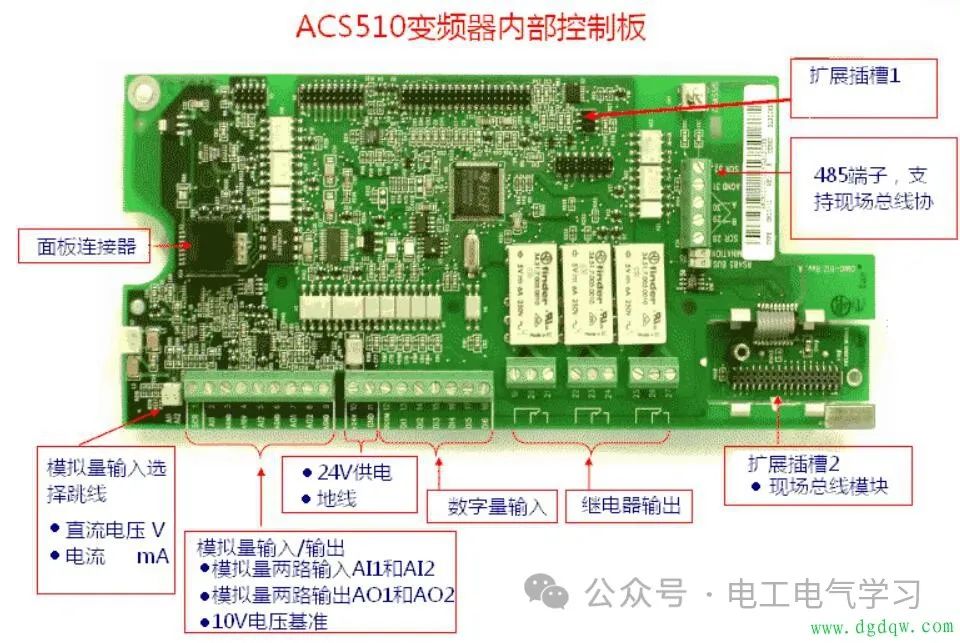The inverter circuit board is a core component of the inverter, responsible for controlling and regulating its operation. This article will provide a detailed introduction to various components on the inverter circuit board, including resistors, capacitors, inductors, diodes, transistors, IGBTs, optocouplers, and crystal oscillators.

1. Resistors
Resistors are commonly used components on circuit boards, used to limit current. In inverter circuit boards, the symbol for resistors is represented by the letter R. Based on resistance characteristics, resistors can be classified into fixed resistors, variable resistors, and special resistors. Based on materials, resistors can be divided into carbon film resistors, metal film resistors, wire-wound resistors, non-inductive resistors, and thin-film resistors. Based on installation methods, resistors can be categorized into through-hole resistors and surface-mount resistors. Based on function, resistors can be classified into load resistors, sensing resistors, shunt resistors, and protection resistors.
2. Capacitors
Capacitors are energy storage components that have the function of blocking direct current while allowing alternating current to pass. In inverter circuit boards, capacitors are mainly used for filtering, coupling, and resonance. Based on usage, capacitors can be classified into oscillation capacitors, correction capacitors, deflection capacitors for cathode ray tubes, current-limiting capacitors, filter capacitors, isolation capacitors, and compensation capacitors.
3. Inductors
Inductors are components that convert electrical energy into magnetic energy and store it. In inverter circuit boards, inductors are mainly used for filtering, coupling, and interference suppression. Based on usage, inductors can be classified into oscillation inductors, correction inductors, deflection inductors for cathode ray tubes, current-limiting inductors, and filter inductors.
4. Diodes
Diodes are electronic components that have unidirectional conductivity. In inverter circuit boards, diodes are mainly used for rectification and freewheeling. When a forward voltage is applied, the diode conducts; when a reverse voltage is applied, the diode is cut off.
5. Transistors
Transistors are current-controlled components that amplify signals. In inverter circuit boards, transistors are mainly used for signal amplification and processing. Based on material, transistors can be classified into silicon transistors and germanium transistors; based on structure, they can be classified into NPN and PNP types; based on function, they can be classified into switching transistors, power transistors, Darlington transistors, and phototransistors; based on power, they can be classified into low-power, medium-power, and high-power transistors; based on operating frequency, they can be classified into low-frequency, high-frequency, and ultra-high-frequency transistors; based on structural technology, they can be classified into alloy transistors and planar transistors; based on installation methods, they can be classified into through-hole transistors and surface-mount transistors.
6. IGBT
IGBT (Insulated Gate Bipolar Transistor) is a voltage-controlled component characterized by fast switching speed and low power consumption. In inverter circuit boards, IGBTs are mainly used for controlling high voltage and large current. IGBTs are composite voltage-driven power semiconductor devices composed of BJTs (Bipolar Junction Transistors) and MOSFETs (Metal-Oxide-Semiconductor Field-Effect Transistors).
7. Optocouplers
Optocouplers are devices that transmit electrical signals through light, providing electrical isolation and signal transmission functions. In inverter circuit boards, optocouplers are mainly used for signal isolation and transmission. An optocoupler consists of a light-emitting diode and a phototransistor; when the light-emitting diode emits light, the phototransistor receives the light and generates photocurrent, thus achieving electrical-optical-electrical conversion.
8. Crystal Oscillators
Crystal oscillators are electromechanical devices that utilize the piezoelectric effect of quartz crystals to generate vibration frequencies. In inverter circuit boards, crystal oscillators are mainly used to provide stable clock signals. Crystal oscillators, commonly referred to as crystal resonators, are made from quartz crystals with very low electrical loss, precisely cut and polished, and coated with electrodes and lead wires.
9. Other Components
In addition to the components mentioned above, there are other components on the inverter circuit board, such as multi-pin chips, digital tubes, LCD displays, relays, and buzzers. These components play different roles in the circuit, collectively ensuring the normal operation and stable performance of the inverter.
This article is an exclusive original piece from the Electrical Engineering Learning Network. Unauthorized reproduction is prohibited!